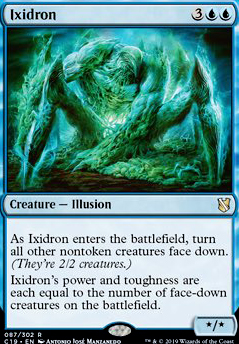Land (36)
- 1x Alchemist's Refuge
- 1x Bojuka Bog
- 1x Breeding Pool
- 1x Command Tower
- 1x Drowned Catacomb
- 1x Exotic Orchard
-
1x
Fabled Passage

- 1x Flooded Grove
-
4x
Forest

- 1x Hinterland Harbor
- 5x Island
- 1x Llanowar Wastes
- 1x Morphic Pool
- 1x Opulent Palace
-
1x
Overgrown Tomb

- 1x Reliquary Tower
- 1x Sunken Hollow
- 2x Swamp
- 1x Temple of Deceit
- 1x Temple of Malady
-
1x
Temple of Mystery

- 1x Twilight Mire
- 1x Underground River
- 1x Watery Grave
- 1x Woodland Cemetery
- 1x Yavimaya Coast
- 1x Zagoth Triome
- 1x Zoetic Cavern
Other (10)
Morphs (27)
- 1x Ainok Survivalist
- 1x Bane of the Living
- 1x Brine Elemental
- 1x Broodhatch Nantuko
- 1x Chromeshell Crab
- 1x Deathmist Raptor
- 1x Den Protector
- 1x Echo Tracer
- 1x Gift of Doom
- 1x Grim Haruspex
- 1x Hooded Hydra
- 1x Icefeather Aven
- 1x Kadena's Silencer
- 1x Kheru Spellsnatcher
- 1x Mischievous Quanar
- 1x Nantuko Vigilante
- 1x Sagu Mauler
- 1x Salt Road Ambushers
- 1x Silumgar Assassin
- 1x Stratus Dancer
- 1x Thelonite Hermit
- 1x Unblinking Bleb
- 1x Vesuvan Shapeshifter
- 1x Voidmage Prodigy
- 1x Weaver of Lies
- 1x Willbender
- 1x Zoetic Cavern
Removal (10)
Commander (1)
Ramp and Fixing (14)
-
1x
Arcane Signet

- 1x Birds of Paradise
- 1x Burgeoning
- 1x Chromatic Lantern
- 1x Cultivate
- 1x Farseek
- 1x Fellwar Stone
- 1x Kodama's Reach
- 1x Nature's Lore
- 1x Sakura-Tribe Elder
- 1x Sol Ring
- 1x Thran Dynamo
- 1x Trail of Mystery
- 1x Zoetic Cavern
Card Advantage (10)
Maybeboard
Morph (36)
- 1x Aphetto Alchemist
- 1x Aphetto Exterminator
- 1x Broodhatch Nantuko
- 1x Coral Trickster
- 1x Dermoplasm
- 1x Disruptive Pitmage
- 1x Dragon's Eye Savants
- 1x Dream Chisel
- 1x Dulcet Sirens
- 1x Ebonblade Reaper
- 1x Fathom Seer
- 1x Hystrodon
- 1x Kin-Tree Warden
- 1x Maelstrom Djinn
- 1x Marang River Skeleton
- 1x Master of the Veil
- 1x Mistfire Weaver
- 1x Monastery Loremaster
- 1x Obscuring Aether
- 1x Pine Walker
- 1x Primal Whisperer
- 1x Quicksilver Dragon
- 1x Raven Guild Master
- 1x Riptide Entrancer
- 1x Riptide Survivor
- 1x Root Elemental
- 1x Ruthless Ripper
- 1x Serpentine Basilisk
- 1x Shorecrasher Elemental
- 1x Silent Specter
- 1x Silumgar Spell-Eater
- 1x Skinthinner
- 1x Soul Collector
- 1x Thousand Winds
- 1x Voidmage Apprentice
- 1x Yedora, Grave Gardener
Draw (6)
- 1x Guardian Project
- 1x Mystic Forge
- 1x Pendant of Prosperity
- 1x Teferi's Ageless Insight
- 1x The Great Henge
- 1x Wavebreak Hippocamp
Ramp (6)
- 1x Azusa, Lost but Seeking
- 1x Sakura-Tribe Scout
- 1x Tempt with Discovery
- 1x The Great Henge
- 1x Thought Vessel
- 1x Wayward Swordtooth
Bounce (5)
Land (3)
Stampede (3)
Manifest (6)
- 1x Cloudform
- 1x Ethereal Ambush
- 1x Jeskai Infiltrator
- 1x Qarsi High Priest
- 1x Temur War Shaman
- 1x Write into Being
Surprise (6)
- 1x Alchemist's Refuge
- 1x Leyline of Anticipation
- 1x Teferi, Mage of Zhalfir
- 1x Tidal Barracuda
- 1x Vedalken Orrery
- 1x Wilderness Reclamation
Other (5)
- 1x Backslide
- 1x Eternal Witness
- 1x Muraganda Petroglyphs
- 1x Opposition Agent
- 1x Ruxa, Patient Professor
Removal (3)
Suggestions
Updates Add
Comments
Attention! Complete Comment Tutorial! This annoying message will go away once you do!
Important! Formatting tips — Comment Tutorial — markdown syntax
Please login to comment
| Date added | 4 years |
| Last updated | 2 years |
| Legality | This deck is Commander / EDH legal. |
| Rarity (main - side) | 6 - 0 Mythic Rares 53 - 0 Rares 18 - 0 Uncommons 12 - 0 Commons |
| Cards | 100 |
| Avg. CMC | 3.34 |
| Tokens | Beast 3/3 G, 2/2 G Token Creature Cat, Insect 1/1 G, Manifest 2/2 C, Morph 2/2 C, Saproling 1/1 G, Snake 1/1 G |
| Folders | Reference Decks |
| Votes | |
| Ignored suggestions | |
| Shared with | |
| Views |


